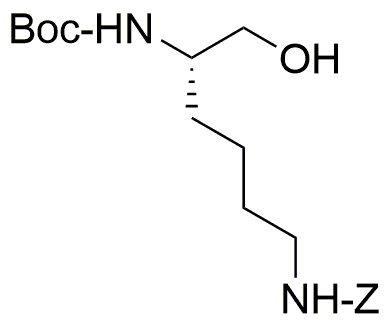Na-Boc-Ne-Z-L-lysinol is widely utilized in research focused on:
- Peptide Synthesis: This compound is a valuable building block in the synthesis of peptides, particularly in the development of therapeutic proteins and vaccines.
- Drug Development: It plays a crucial role in the pharmaceutical industry for creating drug candidates with improved bioavailability and stability, enhancing their effectiveness.
- Bioconjugation: Researchers use it for bioconjugation processes, allowing the attachment of biomolecules to drugs or imaging agents, which is essential in targeted therapy.
- Analytical Chemistry: The compound serves as a standard in analytical methods, aiding in the quantification and characterization of complex biological samples.
- Material Science: It is also explored in the development of novel materials, such as hydrogels, which have applications in drug delivery systems and tissue engineering.
General Information
Properties
Safety and Regulations
Applications
Na-Boc-Ne-Z-L-lysinol is widely utilized in research focused on:
- Peptide Synthesis: This compound is a valuable building block in the synthesis of peptides, particularly in the development of therapeutic proteins and vaccines.
- Drug Development: It plays a crucial role in the pharmaceutical industry for creating drug candidates with improved bioavailability and stability, enhancing their effectiveness.
- Bioconjugation: Researchers use it for bioconjugation processes, allowing the attachment of biomolecules to drugs or imaging agents, which is essential in targeted therapy.
- Analytical Chemistry: The compound serves as a standard in analytical methods, aiding in the quantification and characterization of complex biological samples.
- Material Science: It is also explored in the development of novel materials, such as hydrogels, which have applications in drug delivery systems and tissue engineering.
Documents
Safety Data Sheets (SDS)
The SDS provides comprehensive safety information on handling, storage, and disposal of the product.
Product Specification (PS)
The PS provides a comprehensive breakdown of the product’s properties, including chemical composition, physical state, purity, and storage requirements. It also details acceptable quality ranges and the product's intended applications.
Certificates of Analysis (COA)
Search for Certificates of Analysis (COA) by entering the products Lot Number. Lot and Batch Numbers can be found on a product’s label following the words ‘Lot’ or ‘Batch’.
Numéro de catalogue
Numéro de lot/série
Certificates Of Origin (COO)
This COO confirms the country where the product was manufactured, and also details the materials and components used in it and whether it is derived from natural, synthetic, or other specific sources. This certificate may be required for customs, trade, and regulatory compliance.
Numéro de catalogue
Numéro de lot/série
Safety Data Sheets (SDS)
The SDS provides comprehensive safety information on handling, storage, and disposal of the product.
DownloadProduct Specification (PS)
The PS provides a comprehensive breakdown of the product’s properties, including chemical composition, physical state, purity, and storage requirements. It also details acceptable quality ranges and the product's intended applications.
DownloadCertificates of Analysis (COA)
Search for Certificates of Analysis (COA) by entering the products Lot Number. Lot and Batch Numbers can be found on a product’s label following the words ‘Lot’ or ‘Batch’.
Numéro de catalogue
Numéro de lot/série
Certificates Of Origin (COO)
This COO confirms the country where the product was manufactured, and also details the materials and components used in it and whether it is derived from natural, synthetic, or other specific sources. This certificate may be required for customs, trade, and regulatory compliance.


